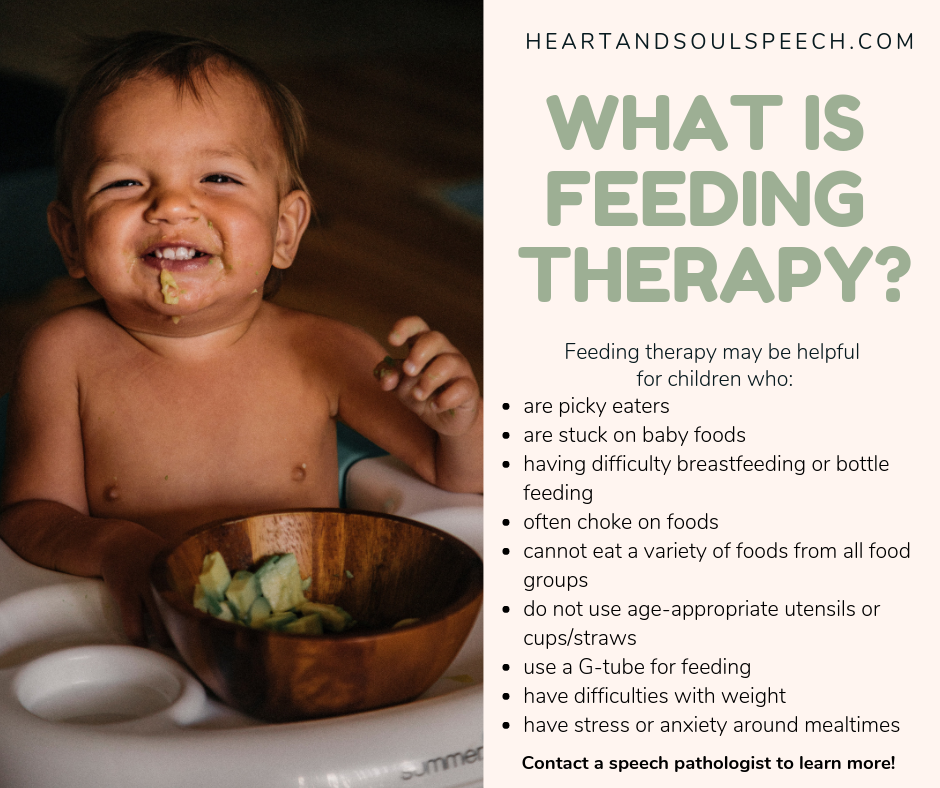Mealtime meltdowns are not new to parents and caregivers, especially those with “picky” eaters. Feeding therapy may help increase a child’s variety of accepted foods, ability to participate in family meals, and decrease the family stress related to food.
What is feeding therapy?
There are two main goals to feeding therapy:
- Learn how to eat safely using age-appropriate biting, chewing, and swallowing skills
- Learn how to eat a variety of foods and drinks without aversion, stress, or anxiety

Who provides feeding therapy?
Typically, a speech-language pathologist (SLP) or occupational therapist (OT) will provide feeding therapy. The pediatrician also is included in the plan of care. Sometimes a registered dietician or nutritionist will be included in the care team as well. It is important to note, “feeding” is a specialty practice and not all SLPs or OTs will have experience or education in providing feeding therapy, especially with children. Ask questions about your therapist’s training and approach to feeding therapy to ensure it’s a good fit for your needs.
Who needs feeding therapy?
These may be signs of a feeding disorder and could indicate the need for a feeding evaluation.
- Difficulty chewing foods safely
- Difficulty swallowing foods safely
- Refusal or avoidance of certain food textures, temperatures, colors, flavors, food groups
- Gagging or vomiting often on certain foods or drinks
- Coughing or choking often when eating
- Difficulty moving food around in the mouth before swallowing
- Fussy or irritable at mealtime
- Difficulty drinking liquids from age-appropriate cup/bottle
- Reflux issues
- Not meeting feeding development milestones
- Refuses or rarely tries new foods
- Has difficulty transitioning from gastric tube (G-tube) feedings to oral feedings
- Unexpected mealtime behaviors, such as crying, turning away from food, food refusal, not opening the mouth for food, etc.
- Mealtimes take longer than 30 minutes for infants, and 30-40 minutes for toddlers or young children.
- “Picky eaters” or children who only eat a limited variety or types of foods
- Anxiety or stress around mealtimes for family or child
- Poor weight gain, weight loss, or difficulty maintaining weight
- Overstuffing mouth with too much food
- Difficulty breastfeeding
- Difficulty transitioning to new foods or weaning off “baby” foods
- Inability to drink from a cup or straw
- Concerns with adequate nutrition and hydration
How does feeding therapy help?
—Feeding therapy should address the whole child. Each child will have different strengths and needs. Therefore, both medical and social aspects are important to consider when planning comprehensive care.
—Feeding your child is emotional. Responsive feeding practices nurturing, trust, shared responsibility, and patience. Strategies are taught to promote the child’s positive relationship with food and increase the caregivers’ response to their child at meals.
—Feeding is social. When your child cannot participate in mealtimes as expected, it becomes difficult to enjoy sharing a family meal, talk about food, or share your favorite treat. Decreasing family stress is often a primary goal of feeding therapy.
—Feeding requires oral motor skills. Coordination, strength, and range of motion are all important skills needed to safely bite, chew, suck, and swallow a variety of foods and liquids. Therapy may include strategies and exercises to increase these skills, if needed.
—Feeding is routine. Mealtimes can often be very stressful for families of children with feeding difficulties. Responsive feeding therapy focuses on the child’s perspective of food and expands acceptance and abilities to manage all foods through play and exposure in a supportive environment.
Exposure and experience to variety of foods
– without pressure –
is the key!
Why is feeding therapy important?
Feeding and swallowing disorders can increase a child’s risk of malnutrition, dehydration, poor growth/development and immunity, hospitalization, choking, prolonged caregiver dependence, exacerbation of oral aversion, and extremely limited acceptance of foods from all food groups. Additionally, children who cannot participate in shared meals with family and friends often report feeling isolated, stressed, and anxious and may have poor body image or self-esteem.
Why is a variety of foods important?
The easiest and quickest way to increase nutrients into our diet is to increase the colors on our plate. Children with feeding disorders often retreat to the “easy” foods–bland in flavor, white, and crunchy. Think all the carbs. It’s fun to talk about the “rainbow foods” on their plate, like brightly colors fruits and vegetables, which of course are nutrient dense!
How long does feeding therapy take?
The length and frequency of therapy depends on the child’s needs, but feeding therapy takes time. Eating is a developmental process. Regardless of age, a process of very small steps is required to learn or re-learn the oral motor skills or acceptance of food needed for healthy eating.
How do I get feeding therapy?
Talk with your child’s pediatrician to get a referral to a feeding therapist in your area. There are many different settings in which feeding therapy is offered, so asking what’s available in your area may guide your decision. Remember–physicians are often a good first stop for questions, but if you still have concerns, seek another opinion from a feeding expert.
What are some things I can do at home to help?
Here’s our top 10 strategies to help your child increase variety, acceptance, and independence during meals.

2 Responses